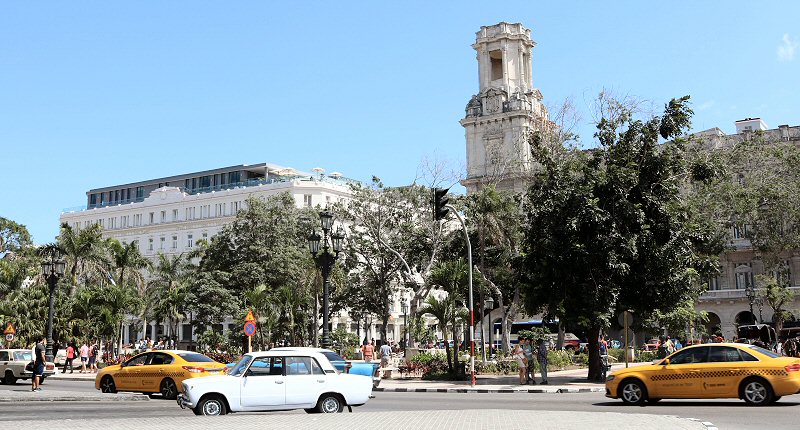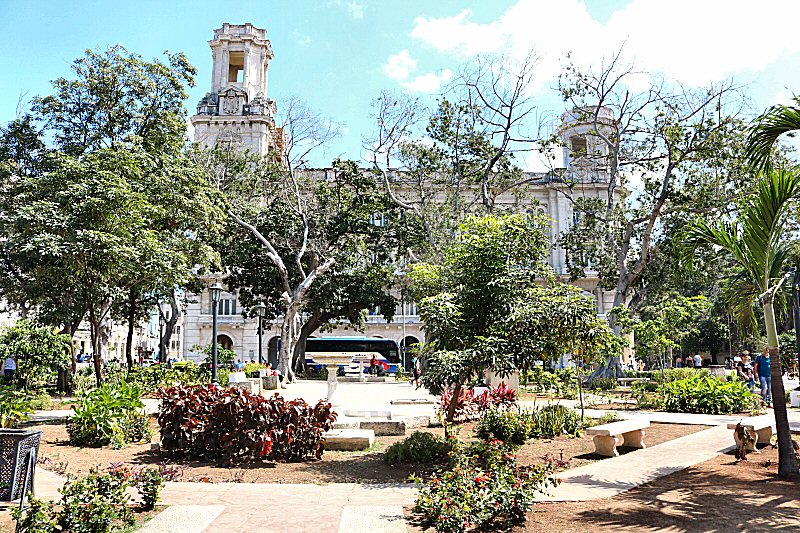
The Parque Central is located close to the Capitolio, bordered by the Paseo de Martí, the Agromonte, the San José, and the Neptuno streets.
Parque Central
After the city wall was
demolished in the area in 1863, where the Parque Central
stands today, the place stayed as an empty place along the
Alameda de Isabel II for a long time until 1875, when the
statue of the Spanish Queen Isabel II was erected. The
construction of a park around the statue was completed in
1877. Initially, the park was pretty much bare of trees, but
mostly paved, and it had the current dimensions. The statue
of Isabel II was removed from its pedestal during the US
intervention in Cuba in 1899. In 1902, on the occasion of
the declaration of the Republic and on the order of the
Mayor Pedro Perfecto Pascual Lacoste, a statue made of
molten calamine, representing the freedom, was placed on the
same pedestal , but soon the cyclone brought it down in ruins.
On the other hand, a new committee
was constituted in Guanabacoa in 1900 to build a statue of
José Martí in the new park, as José Martí had received the
highest vote on a popular survey that had been conducted by
the Cuban pictorial El Fígaro to determine whose statue
should be erected in that park. The committee determined
that the expense of the statue would be borne by the
donations of the public and each donation would not exceed
25 cents. Two years later the Cuban sculptor José Vilalta de
Saavedra was entrusted with the construction of the
monument. José Vilalta de Saavedra was also the designer of
the monument, erected to pay tribute to the eight medical
students that were shot in 1871, the sculptural set Las Virtudes (the
Virtues) of the Cemetery of Columbus in
Havana, the monument of Francisco de Albear and several
busts of important protagonists of Cuban history.
The first stone of the monument was
placed by the General Maxímo Gomez, the Major General of
the Liberation Army, in 1904 and the statue of José Martí,
the first statue of the hero in Cuba, was unveiled by the
President Tomás Estrada Palma in the park that was adorned
with national colors, in 1905. At dawn the city woke up with
a salvo of 21 shots of the cannons from the Fortaleza de San
Carlos de la Cabaña, announcing the opening ceremony of the
monument. The solemn ceremony was attended also by Doña
Leonor Pérez, the mother of the hero, her sister Amelia and
the widow Carmen Zayas-Bazán. Since then, the old square
Isabel II began to be called by the inhabitants of the
capital the Parque Central, most likely due its central
location on the Paseo de Martí.
Juana de Verona, the sister of the Bernabé de Varona, the General of the Liberation Army known as Bembeta, placed a golden nail with the inscription “La Hermana de Bembata (Bembeta’s Sister)” inside the pedestal, along with the lead box that contained several copies of the pictorial El Fígaro, the Cuban newspapers La Discusión and the Diario de la Marina y Patria, and some coins.
In 1959 trees, fountains and
sculptures were incorporated in the park.
The Parque Central is surrounded by
significant buildings, such as the Gran Teatro de La Habana
and the building devoted to international art of the Museo
de Bellas Artes (Centro Asturiano de la Habana)); the
hotels, such as Gran Hotel Manzana Kempinski, Plaza, Parque
Central, Inglaterra, Telégrafo; and the shopping center,
known as Manzana de Gómez.
The Parque Central can be divided in
three sections: the esplanade with the statue of José Martí
in the center, and the green areas at both sides of the
esplanade.
Right in the center of the esplanade
stands the statue of José Martí, made of white marble of
Carrera. It is erected on the site that was occupied by the
marble statue of Isabel II until 1899. The statue is 2.75
meters high. Its total height with the pedestal reaches
about 8 meters. It was carved in the studio of the Cuban
sculptor José Vilalta de Saavedra in Rome that did not
charge a penny for his work. Furthermore, the amount
collected by the commission did not cover the amount that
was necessary for the expenses (4.500 $), so the sculptor
had to complete it from his own resources. The image of José
Martí looks like making again a speech to the Cubans of all
times. The date of his death is carved below the reliefs of
the Phrygian cap and the coat of arms of Cuba. The pedestal
is surrounded by bas-reliefs of human figures that consist
of the members of the Liberation Army, as well as the public
itself.
In the green areas small squares are
connected with each other by a series of paths that
intersect each other. The small squares are adorned by
centenarian trees, fountains and small sculptures and
bordered by stone benches. The statue of José Martí is
encircled by 28 royal palms that signify his birthday on
January 28. There are also eight coffin-shaped stonework,
representing the eight medical students shot by the Spanish
on November 27, 1871.
The park, once hosted the city’s
first book fairs, now hosts the artwork and book sales,
photo exhibitions, a tourist transport bus stop and that of
horse drawn carts. For decades it has been the home to the
La Esquina Calinete (Hot Corner), a space where passionate
baseball fans laughed, shouted and discussed the statistics,
the chances of their teams playing the final and the habits
of their favorite players. The section of the Agromonte
street that is neighboring to the Parque Central is the
parking area of vintage cars. The Parque Central is a great
city crossroads and a meeting point for Cubans; it is always
alive, as thousands of habaneros cross it every day,
disappearing in all directions.

